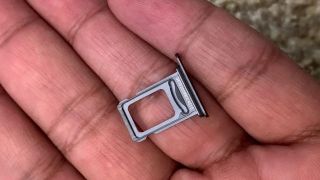The iPhone now supports dual SIM but what about dual apps?
To put dual SIMs to best use

With the latest iPhone XS release, the iPhone finally, officially supports dual SIM capabilities. There are plenty of reasons why many people are excited about this feature landing on the iPhone as this allows you to have the flexibility of using one phone for your work number as well as your personal number, or use different carriers for voice calls and data.
Depending on which part of the world you live in, the iPhone XS and the iPhone XS Plus (and soon the iPhone XR) either have a tray that can take dual SIM cards or work have a tray that takes one nano SIM card like previous iPhones and have one built-in eSIM. An eSIM is an electronic version of the SIM card and pretty much the future of using all phones. With the iPhone XS, Apple is sending a message to carriers that it’s time to start implementing eSIM technology.
The dual-sided dual SIM tray on the iPhone XS Abbas Ali
A photo posted by @ajaffarali on Sep 24, 2018 at 8:13am PDT
Although Apple hasn’t enabled eSIM on the iPhone XS just yet, it is expected to do so in a future iOS update. But the Chinese variant of the iPhone XS has a tray for two physical SIM cards and we managed to get our hands on one to see how dual SIM technology works on the iPhone.
We like how Apple has used a double-sided SIM tray to house both the SIM cards. Apple has done this by adding a little piece on bendable plastic that pushes down and keeps the secondary SIM card from falling off when it’s facing down. It’s a nice little tweak to keep the SIM card locked in its place and we wonder why Apple hasn’t done this for the primary SIM card as well.
Almost all Android phone we’ve recently looked at have a tray with two slots next to each other with the second slot used either for a SIM card or an SD card. Using a double sided tray could help all Android manufacturers build support for dual SIMs AND a microSD card and not have consumers decide between one or the other.
Coming to the functionality of dual SIM cards on the iPhone, it’s very much like what we’ve seen on Android phones over the last few years. You can independently choose which SIM you want to use for phone calls, messaging and data, and, can rename each of the SIM cards to help you easily distinguish between the two.

When you’re calling someone, you can select which SIM you want to use for outgoing calls. A small button appears on top the dialter that lets you switch between the SIM cards on the phone.. When you receive an incoming call, iOS 12 lets you know which SIM the call is coming through and the Call History screen also shows which SIM was used for each call.
Get daily insight, inspiration and deals in your inbox
Get the hottest deals available in your inbox plus news, reviews, opinion, analysis and more from the TechRadar team.
The functionality of the iPhone using either two physical SIM cards or using an eSIM as well as a regular SIM card is expected to be the same so whenever Apple enables eSIM functionality on the iPhone XS and XR, expect it to work much like what we’ve described above.
However, there is one particular area where the iPhone will need to catch up with Android phones and we’re not quite sure if Apple will allow this in future iOS updates. It’s called App twinning or App cloning which basically allows you to have two instances of an app working independently of each other.
To give you an example, with two numbers on your phone, you might also want two different WhatsApp accounts. Most Android phones with dual SIM cards will allow you to create a clone of WhatsApp and use it with your secondary number.
However, this is not possible on the iPhone just yet. Either Apple will need to build support for app cloning in iOS or app developers such as WhatsApp will need to extensively rewrite their apps to support working with multiple numbers.
At the moment, either of those options options look a bit unlikely but then again, so was the thought of having a dual SIM iPhone a couple of years back.

Abbas has been living and breathing tech before phones became smart or clouds started storing data. It all started when he got his very first computer- the Sinclair ZX Spectrum. From computers to mobile phones and watches, Abbas is always interested in tech that is smarter and smaller because he believes that tech shouldn’t be something that gets added to your life- it should be a part of your life.
